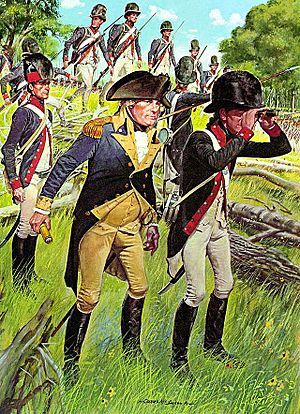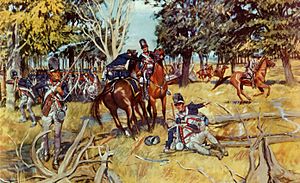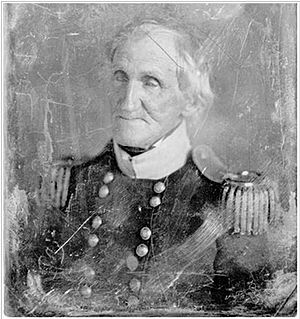Legion of the United States facts for kids
Quick facts for kids Legion of the United States |
|
|---|---|

Major General Anthony Wayne with the Legion of the United States, 1794
|
|
| Active | 1792–1796 |
| Country | |
| Type | Combined arms |
| Role | Pacify Native-American tribes, secure western border for settlement |
| Size | 2,631 |
| Colors | Unit Colors:
|
| Engagements | Northwest Indian War |
| Disbanded | 1796 |
| Commanders | |
| First Commander | Major General Anthony Wayne |
| Second Commander | Brigadier General James Wilkinson |
The Legion of the United States was a special army unit that existed from 1792 to 1796. It was led by Major General Anthony Wayne. This group was a new version of the Continental Army, which fought during the American Revolutionary War.
After the war, the United States was a new country. It decided to have a professional army instead of relying on state militias. The Legion was created to protect the country's western borders. It also aimed to deal with Native American tribes in the Ohio area. The Legion was made up of four smaller units called sub-legions. Each sub-legion had its own infantry (foot soldiers), cavalry (soldiers on horseback), riflemen, and artillery (big guns).
The Legion is most famous for winning the Battle of Fallen Timbers in August 1794. This victory helped lead to the Treaty of Greenville in 1795. This treaty brought peace with many Native American nations. After this, the Legion became smaller and was renamed the United States Army in 1796. Today, some parts of the modern U.S. Army, like the 1st, 3rd, and 4th Infantry Regiments, can trace their history back to the Legion.
Contents
Why the Legion Was Formed
After the American Revolutionary War, the U.S. government mostly got rid of its army. By 1784, there were only a few soldiers left to guard military supplies. However, by 1785, Congress decided to create a small force of 700 soldiers. These soldiers were meant to serve in the western territories. Their job was to remove illegal settlers and protect those who had bought land from the U.S. government. Many people at the time were worried about having a large standing army. So, the U.S. mainly depended on volunteer state militias.
Early Challenges in the Northwest Territory
In 1789, the new U.S. government created the United States Department of War. Henry Knox became its first leader. He ordered Colonel Josiah Harmar to lead an attack against Native Americans in the Northwest Territory. Harmar's force included about 300 federal soldiers and 1,000 militia. They had problems with equipment and supplies. In September 1790, Harmar's group marched to Kekionga (near modern-day Fort Wayne, Indiana). They were badly defeated there.
President George Washington then ordered another expedition. This one was led by General Arthur St. Clair. His force was about 2,400 soldiers. Many of these soldiers were new and lacked experience. On November 4, 1791, Native American forces attacked St. Clair's camp. This attack was led by Little Turtle and Blue Jacket. St. Clair's Defeat was one of the worst losses in U.S. Army history. More than half of his soldiers were killed or wounded.
Creating a Stronger Army
These defeats showed Congress that a larger, professional army was needed. So, they approved a federal army of 5,190 soldiers. President Washington chose Anthony Wayne to lead this new army. Wayne was known for being a strong leader.
Wayne and his advisors decided to create a "Legion." This was a special type of army unit. It would combine all types of soldiers: cavalry (horseback), infantry (foot soldiers), and artillery (big guns). This way, they could work together effectively. Congress agreed to this plan. They also passed laws that gave President Washington more power over state militias during emergencies.
How the Legion Was Organized
The Legion was formed from the remaining soldiers of earlier regiments and new recruits. It was hard to find new soldiers after the earlier defeats. Although over 4,000 soldiers were planned, only 2,631 joined the Legion.
Structure of the Legion
The Legion was made up of four sub-legions. Each sub-legion was a complete unit on its own. It had:
- Two battalions of infantry (foot soldiers).
- A rifle battalion (light infantry who were good at shooting from a distance).
- A troop of Light Dragoons (soldiers on horseback).
- Artillery companies (soldiers who operated cannons).
- Medical personnel.
These sub-legions were like early versions of today's brigade combat teams. Major General Wayne commanded the entire Legion. Brigadier General James Wilkinson was his second-in-command.
Uniforms and Appearance
General Wayne wanted each sub-legion to have its own unique cap.
- The 1st sub-legion wore black caps with white trim.
- The 2nd wore white caps with red trim.
- The 3rd wore black caps with yellow trim.
- The 4th wore white caps with green trim.
Each sub-legion also had its own flag with these colors. Wayne ordered his officers to wear the same uniforms as regular soldiers. This was because Native Americans often targeted officers in battles. Soldiers were expected to look neat and clean. They could even be punished for having a dirty uniform.
What the Legion Could Do
Soldiers in the Legion were trained to fight in small, separate groups. General Wayne's plan was to move quickly and attack with bayonets (knives attached to rifles). The infantry used muskets from the Revolutionary War. They were trained to fire quickly and aim for the enemy's body. Wayne even changed the muskets to help soldiers reload faster.
The Legion also had 360 riflemen. These soldiers were very good shots. They were armed with long rifles. They were trained to hit targets from far away.
The artillery unit had 120 soldiers and 16 guns. Wayne wanted lighter cannons that could be carried on horseback. These guns could fire different types of shots, including explosive shells. Gun crews were trained to fire every 15 seconds.
A group of about 200 light dragoons (cavalry) was also part of the Legion. They were armed with pistols, sabers (swords), and carbines (short rifles). They had to protect their horses, which were very valuable.
Nearly 1,500 mounted Kentucky militia (volunteer soldiers) also joined the Legion. They were used to help the dragoons. Many of them had experience in the territory. The Legion also had a small group of elite rangers. These rangers were mainly used to gather information. Later, a new group of scouts and spies was formed. This group was led by William Wells, who had joined the Legion unexpectedly.
Where the Legion Was Stationed
The Legion set up the U.S. military's first basic training facility at Legionville in western Pennsylvania. This was done to keep soldiers away from the bad influences of Pittsburgh. In 1793, the Legion moved by boat down the Ohio River. They set up a camp near Fort Washington.
Later, the Legion moved north into Native American territory. They built Fort Greene Ville. Here, they were joined by the Kentucky Militia. The Legion also occupied Fort Knox in Vincennes.
To protect his soldiers and supply lines, General Wayne built a line of forts stretching north. These forts were garrisoned (had soldiers stationed there) with trained legionaries. This chain of forts eventually reached towards Lake Erie. It included important forts like Fort Recovery, built where St. Clair was defeated, and Fort Defiance. Wayne also had the Legion build Fort Wayne. This fort helped show U.S. control over the large Native American city at Kekionga. The Legion also took over Fort Lernoult (Detroit) after the British left.
Battles and Campaigns
The Legion faced many attacks on its supply convoys as it moved into Native American lands. Fort Jefferson and its supply trains were often under attack from 1792 to 1795. Wayne sent up to 500 soldiers to guard each supply convoy. In 1794, Great Britain built Fort Miami south of Lake Erie. This angered Wayne, but he agreed to add Kentucky militia to his forces.
The Siege of Fort Recovery
On June 30, 1794, a group of 2,000 Native Americans attacked a supply convoy outside Fort Recovery. Major William Friend McMahon, who led the convoy, was killed. The remaining soldiers fled into the fort. Then, a full attack was made on the fort itself. About 125 soldiers defended the fort. Many of them were expert riflemen, and the fort also had artillery. The battle lasted two days, but the Legion held control of the fort. Some historians believe more Native American warriors were involved in this attack than in the later Battle of Fallen Timbers.

The Battle of Fallen Timbers
The most important battle for the Legion was the Battle of Fallen Timbers. This battle happened on August 20, 1794, near modern-day Toledo, Ohio. By this time, many Legion soldiers were guarding supply trains and forts. So, the Legion had less than half its full strength.
General Wayne divided the Legion into three parts. Wayne himself commanded the center. Colonel Hamtramck led the left side, and General Wilkinson led the right side. General Scott commanded the Kentucky militia. The Legion advanced and found an ambush in an area with many fallen trees. When the Legion's front line was attacked, they quickly moved forward with bayonets. The Native American forces could not regroup and retreated to the nearby British-controlled Fort Miami. However, the British commander refused to open the gates. This forced the Native American forces to leave the area.
The battle lasted only about an hour. But it was a big success for the Legion. This victory was due to the intense training and discipline of Wayne's soldiers. Wayne waited in the area for a few days, but no new attack came. His supply trains, however, continued to be attacked.
After the Battle
In September, Wayne led the Legion to Kekionga, where Harmar had been defeated earlier. Here, the Legion built Fort Wayne. Wayne left Colonel Jean François Hamtramck in charge of Fort Wayne. That winter, the Legion built more forts to strengthen their defenses.
On August 3, 1795, the Treaty of Greenville was signed. This treaty officially ended the Northwest Indian War. In 1796, Major General Anthony Wayne accepted the surrender of all British forts that were illegally located within the United States.
The U.S. Department of War used about 40% of the country's budget. So, in 1796, with less threat from Native Americans or the British, Congress reduced the Legion's size. It was then renamed the United States Army. The four sub-legions became the 1st, 2nd, 3rd, and 4th Regiments of the Army. General Wayne died on December 15, 1796. His second-in-command, Brigadier General James Wilkinson, became the Senior Officer of the Army.
Important People and Legacy
Notable Members of the Legion
Many important people served in the Legion of the United States:
- Lieutenant William Henry Harrison: He was Wayne's assistant and later became the 9th President of the United States.
- Lieutenant William Clark: He later helped lead the famous Lewis and Clark Expedition.
- Ensign Meriwether Lewis: He was present at the Treaty of Greenville and also co-led the Lewis and Clark Expedition.
- Captain William Eaton: A diplomat and military leader.
- Captain William Wells: He was the son-in-law of Miami chief Little Turtle. He joined the Legion and led Wayne's intelligence (scouting) team.
Modern Army Connections
The Legion of the United States has a lasting impact on the modern U.S. Army.
- The 1st Sub-Legion is connected to today's 3rd United States Infantry Regiment (The Old Guard). Their uniform crest shows a black hat with a white plume, which were the colors of the 1st Sub-Legion.
- The 2nd Sub-Legion is connected to the 1st Infantry Regiment. The red color on the 1st U.S. Infantry Regiment's coat of arms honors the 2nd Sub-Legion.
- The 4th Sub-Legion is connected to the 4th Infantry Regiment. The green and white colors on the 4th U.S. Infantry Regiment's coat of arms honor the 4th Sub-Legion.



